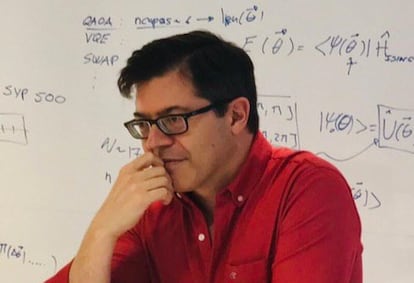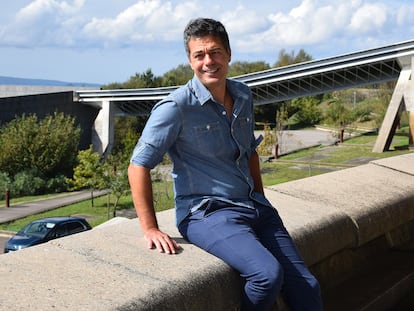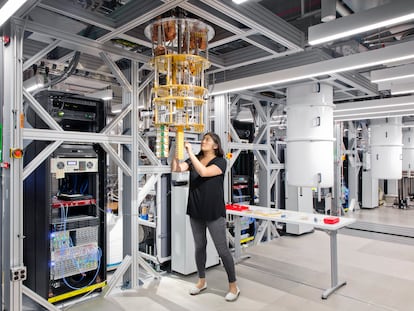Quantum computing in healthcare: predicting diseases and improving patient care
Researcher José Luis Salmerón successfully applies quantum processing models to prognosticate outcomes and treatments

Sergio Boixo, from Google’s Quantum Artificial Intelligence (AI) research group, says that “quantum computing is in its infancy.” The relative youth of this technology makes it difficult to predict its future, but it’s already showing some promising developments. José Luis Salmerón wears many hats — director of the Data Science Lab at CUNEF University in Spain, associate researcher at the Autonomous University of Chile, and principal AI and quantum scientist at the Capgemini consulting firm. Collaborating with a thyroid surgery team at Sagunto Hospital in Valencia (Spain), Salmerón recently tested the potential of quantum computing to predict postoperative complications. But this wasn’t the first application of quantum computing in healthcare. McGill University in Canada has launched the Cardio-Twin project, which creates digital twins to detect health risks in women. Quantum computing is well on its way to providing valuable assistance to healthcare professionals.
“Doctors know basic statistics and have a lot of data at their disposal,” said Salmerón. “The Sagunto Hospital team wanted to predict potential hypocalcemia in patients undergoing thyroid surgery. I proposed a highly reliable prediction model with a variational quantum circuit and achieved a 92% accuracy rate, much more than what could be achieved with conventional techniques.” Salmerón published the results in Mathematics with Dr. Isabel Fernández-Palop and the team from Sagunto Hospital.
Salmerón, one of the most-cited scientists according to Elsevier and Stanford University, has developed an algorithm that utilizes hormonal levels as inputs. By leveraging advanced computer systems, the algorithm predicts the likelihood of hypocalcemia, the most prevalent complication after a thyroidectomy for cancer. “The circuit is not physical, but logical — it’s in the computer code. We sometimes make physical quantum sensors for certain things, but in this case it was a variational programmed circuit,” said Salmerón. The scientist acknowledges that theoretical physics currently dominates the realm of quantum research. However, he prefers to focus on practical applications and strives to “keep things grounded.”
The same journal also published a study by McGill University that used fuzzy cognitive maps (graphs of causal relationships to study effects and alternatives) with a quantum-learning algorithm aimed at the early detection of rheumatoid arthritis, while classifying six severity levels of the disease. “Early diagnosis of rheumatoid arthritis is very crucial in preventing the disease’s progression. However, it is a complicated task for General Practitioners (GPs) due to the wide spectrum of symptoms, and progressive changes in the disease’s direction over time,” wrote Salmerón in another study published in Neurocomputing. A test of these models at Seyyed-al Shohada University Hospital in Iran yielded a 90% accuracy rate.
These methods have also been used in radiotherapy treatment planning, where cognitive maps have proven useful in supporting human decision-making. “These systems enable us to optimize service provision and improve treatments,” said Salmerón. “For instance, in the case of hypocalcemia, early detection allows doctors to initiate treatment sooner and minimize its impact. Additionally, these systems aid in medical service planning, benefiting both patients and clinical centers by ensuring resource optimization and early disease detection.” No model — quantum or not — can be universally applied to every pathology. “Every application requires a suitable algorithm for consistent data processing. Each problem demands a specific solution. Even if a quantum circuit can be used, its applicability may vary across cases.”
But the field is wide open. “There are many potential applications that are a natural fit for quantum computing because they are fundamentally quantum in nature,” said Sam Genway of Capgemini’s Quantum Lab. “The interaction of molecules with biological entities within the body is fundamentally quantum mechanical, and in some cases is very hard to model using conventional computers. With quantum computers, however, we will be able to simulate the underlying quantum behavior with unprecedented accuracy.”
‘The first quantum therapy’
A recent study published in Nature Nanotechnology demonstrated how electrically charged molecules were used to trigger the self-destruction of cancer cells in brain tumors that are difficult to treat. The research team believes it developed “the first quantum therapy.”
“Cancer cells are defeated through the precise modulation of biological quantum electron tunneling by ingenious nanoparticles. This triggers a symphony of electrical signals that activate the natural self-destruct mechanism within cancer cells,” explains lead researcher Frankie Rawson. Study co-author Ruman Rahman added, “This research highlights the potential of quantum therapy as a novel technology for communicating with biology. The combination of quantum bioelectronics and medicine brings us closer to a new treatment approach.”
Scientists at the University of Sydney demonstrated the potential of this emerging technology. They used a quantum computer to design and directly observe a critical process in chemical reactions, which was slowed down by a staggering 100 billion times. Vanessa Olaya Agudelo, the main author of the study published in Nature Chemistry, said: “Understanding these fundamental processes within and between molecules unlocks endless possibilities in materials science, drug design and solar energy harvesting.”
Moreover, it can facilitate advancements in studying the human genome by swiftly and dependably reading DNA sequences. These findings could lead to personalized chemotherapy treatments. Recently, researchers utilized quantum computing to differentiate adenosine from other nucleotide molecules in a study published in the Journal of Physical Chemistry B.
“Using a quantum circuit, we demonstrate the ability to detect a nucleotide solely from the measurement data of a single molecule,” said Masateru Taniguchi, lead author of the study. “For the first time ever, a quantum computer has been successfully connected to measurement data for a single molecule. This breakthrough validates the potential of utilizing quantum computers in genome analysis.”
Another application of this new technology are devices that record nerve impulses to control artificial limbs. “The quantum sensors we develop in medical technology align perfectly with our ‘Invented for Life’ philosophy,” said Stefan Hartung, chairman of the board of Bosch Global, a company that is diving deep into this field. According to Bosch, contactless early detection of atrial fibrillation is now possible to prevent fatal strokes, heart failure and dementia.
Sign up for our weekly newsletter to get more English-language news coverage from EL PAÍS USA Edition
Tu suscripción se está usando en otro dispositivo
¿Quieres añadir otro usuario a tu suscripción?
Si continúas leyendo en este dispositivo, no se podrá leer en el otro.
FlechaTu suscripción se está usando en otro dispositivo y solo puedes acceder a EL PAÍS desde un dispositivo a la vez.
Si quieres compartir tu cuenta, cambia tu suscripción a la modalidad Premium, así podrás añadir otro usuario. Cada uno accederá con su propia cuenta de email, lo que os permitirá personalizar vuestra experiencia en EL PAÍS.
¿Tienes una suscripción de empresa? Accede aquí para contratar más cuentas.
En el caso de no saber quién está usando tu cuenta, te recomendamos cambiar tu contraseña aquí.
Si decides continuar compartiendo tu cuenta, este mensaje se mostrará en tu dispositivo y en el de la otra persona que está usando tu cuenta de forma indefinida, afectando a tu experiencia de lectura. Puedes consultar aquí los términos y condiciones de la suscripción digital.
More information
Últimas noticias
Most viewed
- Reinhard Genzel, Nobel laureate in physics: ‘One-minute videos will never give you the truth’
- Oona Chaplin: ‘I told James Cameron that I was living in a treehouse and starting a permaculture project with a friend’
- Pablo Escobar’s hippos: A serious environmental problem, 40 years on
- Charles Dubouloz, mountaineering star, retires at 36 with a farewell tour inspired by Walter Bonatti
- Why we lost the habit of sleeping in two segments and how that changed our sense of time











































